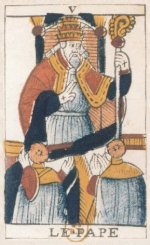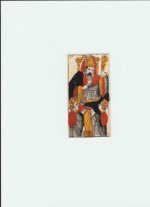jmd
In the Noblet version of the card, what appears behind the figure of the Pope seems to be the backrest of his possible throne. Certainly it has two pillar-like sides which form its frame, but central may be the throne (though more on this a little later).
In contrast, the major versions of the Marseille (Payen, Chosson, Dodal, and Conver) each have clearly only the two pillars, as, it seems, standing clearly as simply such.
At the entrance to King Solomon's Temple were two pillars, each of a particular dimension (refer to Kings or Masonic ritual for specific detail). It could be, then, that the pillars are to depict the entrance to the sacred, in front of which sits the representative of St Peter.
This has a double allusion, for at the gates of Heaven he is claimed, within Catholic legend, to likewise sit, and guard.
St Peter - or the occupier of his chair - here then sits at the entrance to the way into spiritual paradise, and the means to attain such.
In contrast, the major versions of the Marseille (Payen, Chosson, Dodal, and Conver) each have clearly only the two pillars, as, it seems, standing clearly as simply such.
At the entrance to King Solomon's Temple were two pillars, each of a particular dimension (refer to Kings or Masonic ritual for specific detail). It could be, then, that the pillars are to depict the entrance to the sacred, in front of which sits the representative of St Peter.
This has a double allusion, for at the gates of Heaven he is claimed, within Catholic legend, to likewise sit, and guard.
St Peter - or the occupier of his chair - here then sits at the entrance to the way into spiritual paradise, and the means to attain such.



